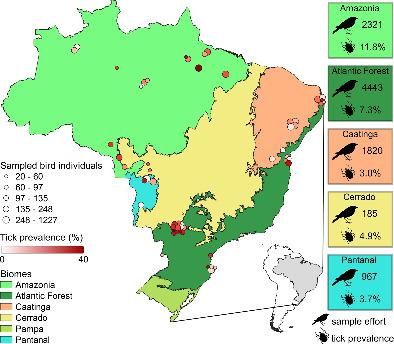当前位置:
X-MOL 学术
›
Med. Vet. Entomol.
›
论文详情
Our official English website, www.x-mol.net, welcomes your
feedback! (Note: you will need to create a separate account there.)
Migration and season explain tick prevalence in Brazilian birds
Medical and Veterinary Entomology ( IF 1.6 ) Pub Date : 2021-05-20 , DOI: 10.1111/mve.12532 A Fecchio 1 , C Lugarini 2 , A Ferreira 3 , J D Weckstein 4, 5 , K M D Kuabara 4, 5 , G M De La Torre 6 , M Ogrzewalska 7 , T F Martins 8, 9 , D de Angeli Dutra 10
Medical and Veterinary Entomology ( IF 1.6 ) Pub Date : 2021-05-20 , DOI: 10.1111/mve.12532 A Fecchio 1 , C Lugarini 2 , A Ferreira 3 , J D Weckstein 4, 5 , K M D Kuabara 4, 5 , G M De La Torre 6 , M Ogrzewalska 7 , T F Martins 8, 9 , D de Angeli Dutra 10
Affiliation

|
Neotropical birds are mostly parasitized by immature ticks and act as reservoir hosts of tick-borne pathogens of medical and veterinary interest. Hence, determining the factors that enable ticks to encounter these highly mobile hosts and increase the potential for tick dispersal throughout migratory flyways are important for understanding tick-borne disease transmission. We used 9682 individual birds from 572 species surveyed across Brazil and Bayesian models to disentangle possible avian host traits and climatic drivers of infestation probabilities, accounting for avian host phylogenetic relationships and spatiotemporal factors that may influence tick prevalence. Our models revealed that the probability of an individual bird being infested with tick larvae and nymphs was lower in partial migrant hosts and during the wet season. Notably, infestation probability increased in areas with a higher proportion of partial migrant birds. Other avian ecological traits known to influence tick prevalence (foraging habitat and body mass) and environmental condition that might constrain tick abundance (annual precipitation and minimum temperature) did not explain infestation probability. Our findings suggest that migratory flyways harbouring a greater abundance of migrant bird hosts also harbour a higher prevalence of immature ticks with potential to enhance the local transmission of tick-borne pathogens and spread across regions.
中文翻译:

迁徙和季节解释了巴西鸟类的蜱流行率
新热带鸟类大多被未成熟的蜱虫寄生,并充当医学和兽医感兴趣的蜱传病原体的宿主。因此,确定使蜱虫能够遇到这些高度移动的宿主并增加蜱虫在整个迁徙飞行路线中传播的可能性的因素对于了解蜱传疾病的传播非常重要。我们使用来自巴西各地调查的 572 个物种的 9682 只鸟类和贝叶斯模型来解开可能的鸟类宿主特征和侵染概率的气候驱动因素,解释可能影响蜱流行的鸟类宿主系统发育关系和时空因素。我们的模型显示,在部分迁徙宿主和雨季,个体鸟类被蜱幼虫和若虫侵染的概率较低。尤其,在部分候鸟比例较高的地区,侵染概率增加。已知影响蜱流行率(觅食栖息地和体重)和可能限制蜱丰度的环境条件(年降水量和最低温度)的其他鸟类生态特征不能解释侵染概率。我们的研究结果表明,拥有更多候鸟宿主的迁徙飞行路线也具有更高的未成熟蜱流行率,有可能增强蜱传病原体的本地传播并跨地区传播。已知影响蜱流行率(觅食栖息地和体重)和可能限制蜱丰度的环境条件(年降水量和最低温度)的其他鸟类生态特征不能解释侵染概率。我们的研究结果表明,拥有更多候鸟宿主的迁徙飞行路线也具有更高的未成熟蜱流行率,有可能增强蜱传病原体的本地传播并跨地区传播。已知影响蜱流行率(觅食栖息地和体重)和可能限制蜱丰度的环境条件(年降水量和最低温度)的其他鸟类生态特征不能解释侵染概率。我们的研究结果表明,拥有更多候鸟宿主的迁徙飞行路线也具有更高的未成熟蜱流行率,有可能增强蜱传病原体的本地传播并跨地区传播。
更新日期:2021-05-20
中文翻译:

迁徙和季节解释了巴西鸟类的蜱流行率
新热带鸟类大多被未成熟的蜱虫寄生,并充当医学和兽医感兴趣的蜱传病原体的宿主。因此,确定使蜱虫能够遇到这些高度移动的宿主并增加蜱虫在整个迁徙飞行路线中传播的可能性的因素对于了解蜱传疾病的传播非常重要。我们使用来自巴西各地调查的 572 个物种的 9682 只鸟类和贝叶斯模型来解开可能的鸟类宿主特征和侵染概率的气候驱动因素,解释可能影响蜱流行的鸟类宿主系统发育关系和时空因素。我们的模型显示,在部分迁徙宿主和雨季,个体鸟类被蜱幼虫和若虫侵染的概率较低。尤其,在部分候鸟比例较高的地区,侵染概率增加。已知影响蜱流行率(觅食栖息地和体重)和可能限制蜱丰度的环境条件(年降水量和最低温度)的其他鸟类生态特征不能解释侵染概率。我们的研究结果表明,拥有更多候鸟宿主的迁徙飞行路线也具有更高的未成熟蜱流行率,有可能增强蜱传病原体的本地传播并跨地区传播。已知影响蜱流行率(觅食栖息地和体重)和可能限制蜱丰度的环境条件(年降水量和最低温度)的其他鸟类生态特征不能解释侵染概率。我们的研究结果表明,拥有更多候鸟宿主的迁徙飞行路线也具有更高的未成熟蜱流行率,有可能增强蜱传病原体的本地传播并跨地区传播。已知影响蜱流行率(觅食栖息地和体重)和可能限制蜱丰度的环境条件(年降水量和最低温度)的其他鸟类生态特征不能解释侵染概率。我们的研究结果表明,拥有更多候鸟宿主的迁徙飞行路线也具有更高的未成熟蜱流行率,有可能增强蜱传病原体的本地传播并跨地区传播。

































 京公网安备 11010802027423号
京公网安备 11010802027423号